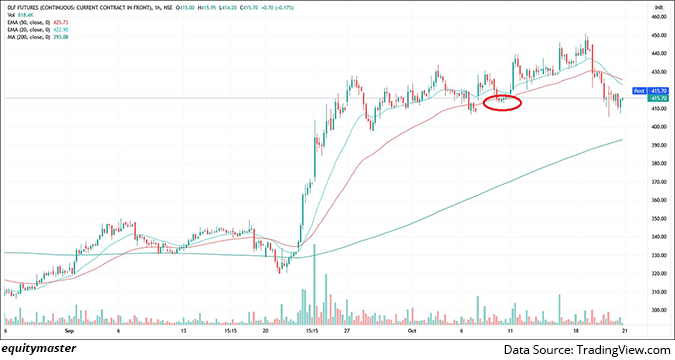How to Know if Your Stock Will Fall

Today I want to share with you some clues the market gives discerning traders before prices fall.
I believe the market gives signals to a trader, i.e. it 'talks' to a trader. But if only the trader is willing to listen to it.
If you are willing to listen to the market, then in this video, I'll show you the signals the market gives you, to find out if a stock is about to go down.
Watch the video and let me know your thoughts. I would love to hear from you.
Hello friends. This is Vijay Bhambwani. I hope you're doing well in the markets and the markets are treating you well.
In this video my friends, I want to share with you a few clues that the market gives to a discerning trader before it wants to come down or before prices are about to fall.
I have always believed that the market tends to give signals to a trader, and to that extent, the market talks to a trader if only the trader is willing to listen.
Don't Miss: Key Information for Long-term Investors
That's not to say that it's as easy as picking up money fallen on a pavement. But the markets do give some tell-tale signs, and today, I want to share some guidelines about how to know if the market is about to go down. By going down, I don't mean necessarily collapse, but maybe correct or it will take a routine pause before it starts to go up again.
Now friends, on your screen is the hourly chart of DLF futures. This is a real estate company and of late it is, at the time of recording this video of course of late, it is under pressure.

Now the first thing that you should look out for if you suspect that the stock is going down or has gone down is, whether the current market price is below a previous swing low. Note how the previous swing low in your chart, on your screen, is marked with a red circle.
Now, as long as the price stays above the previous swing low, the bulls or the buyers are at a definitive discomfort and therefore are possibly likely to unwind their long positions, leading the price even lower.
Now the second thing. If the price is trading on a daily chart, the chart that you're seeing on your screen is hourly but on a daily chart, if the price is trading below its 20 to 25 day moving average, why have I taken a 20 day moving average of maybe 25 day moving average? The logic is absolutely simple because I believe in a 360 degree worldview, I've shared the logic with you.
Now when you take a 20 day moving average, it is spanning the average price of a trader about a month ago. So anybody having bought this particular stock a month ago, as long as the current market price is above the one month average, the bull is incentivised to hold on to his long positions.
It is when the bull witnesses that the current market price is below the holding average period of a month, that he will start to worry and maybe start to offload. So even though this moving average system seems too simplistic, do remember that some of the most beautiful things in life are also the simplest.
Then the red candles, which are the bearish candles, the candles on which the price has declined, tend to be bigger than the green candles. Now green candles are those candles during which the prices have advanced or rallied, which basically tells you that the price is falling faster than it is rising, and even if the prices are rising and there are green candles in the chart, you will see that the price fails to go and test or touch a previous swing high resistance.
This means before it can even reach where people can unwind their long positions because they are hitting a breakeven price, the price falls far before that, which means the price is actually making a lower low and a lower high pattern. So it's drifting lower.
Now let me also bring up a subject on volumes. It is necessary that the price when it rises, it rises on high volumes. But it is not necessary when the price is falling, that it must fall on higher volumes. If it falls on higher volumes, even better because there is participation in the selling and therefore, selling pressure maybe escalating.
But if the price falls on lower volume as compared to the volumes during the up move, don't think that the selling is easier or the selling is smaller. It could also be that the bulls are suffering from shell shock, are basically freezing over till their positions are cut off by their brokers for the want of mark to market payments.
Therefore, volumes on the downsides for protracted periods, if you have been trading in the year 2008, when the markets fell, after June or July 2008, on many occasions when the markets were falling, they were falling on extremely poor volumes. So a lot of people were conjecturing as to whether the markets have hit bottom because the volumes had dried up on the downside. But you know what? The markets actually bottomed in October 2008. So on declines, of volumes can be low because participants are in a state of shock.

Now, on your screen is one of the most important studies, which is the snap quote window. You can bring this up on a desktop or a laptop computer, on most trading terminals by highlighting the counter and clicking on F5. On your mobile phone app most of trading terminals of trading, mobile apps of brokers will bring up this window of the best five buyers and the best five sellers by simply single tapping on the particular counter.
Now, what you can see in this snap quote window is the difference between by and the sell price. Now, this difference is called the spread. In this snap quote window, what you are seeing is the difference is 60 paise. Now a tick price, which means the multiples in which the price can move, a single tick in the F&O on DLF is 5 paise. So what you are seeing is a distance of 12 ticks.
Now the market lot of the DLF is 3,300 shares. So if you multiply 6 paise by 3,300 shares, you know it is Rs 1,980. So if one trade takes place at the buy price and the other takes place at the sell price, the value of the counter has moved Rs 1,980 which is a lot, a lot of money. Why? Because if you feel that you made a mistake in taking a position on the counter and you want to exit, you will have to pay a penalty of 6 paise per share multiplied by 3,300 shares, which is a lot of money. And do remember this Rs 1,980 is gross loss. You will have to pay brokerage, GST, STT etcetera, etcetera, and you will very easily surpass a loss of more than Rs 2,200.
Ideally, the difference between the bid and the offer price in a mid-sized, mid-priced stock should not be more than 2 ticks, which is 10 paise.
Now why my saying that the ticks will be wide because whenever somebody sells in a panic and remember, people want to exit in a falling stock out of their long positions. So every time somebody hits the panic button and sells, the price will start making exaggerated large red coloured candles.
You see now you begin to tie up the two things. I told you in the price chart that in a fall, the red candles will be bigger and the green candles, which are the bullish candles, will be smaller. There you have it. The reason why the red candles will be bigger is because the spreads are so wide that when the first buyer has got his buy quantity because somebody sold in a panic, the next buyer will be at far lower prices because the counter will be illiquid and the bid and offer spreads will be as wide as a jumbo jet.
Now these are direct costs and you should not be trading counters which are high cost counters because your take home profits will be small.
So in a falling market, whether it is a high cost of the low cost counter, the bid and offer spreads will start to widen. And when it starts happening, you should sit up in your chair and start wondering whether the market wants to send you a red flag, a warning sign, that maybe, just maybe, the price is going to come down.
Of course, you must take all these signals are together. Price below previous swing low. Price below its moving average. Bigger red candles as compared to the green candles. The green candles are met with small volumes. Red candles may or may not be accompanied by big volumes. And the snap quote window showing you very large spreads.
Friends do keep this in mind. Keep watching your screens intently and manage to protect yourself whenever the counter that you're trading shows you warning signs.
On this optimistic note, I bid goodbye to you in this video, not before reminding you to click like on this video if you liked what you saw and subscribe to my YouTube channel if you haven't already done so. Click on the bell icon to receive instant alerts about fresh videos being put up out here.
Good, bad or ugly, I'd love to hear from you in the comments section and help me reach out to fellow like-minded investors and traders by referring my video to your family and friends.
Thank you for your patience. Till we meet again in my next video, this is Vijay Bhambwani signing off for now. Take care. Bye, bye.
Warm regards,

Vijay L Bhambwani
Editor, Fast Profits Daily
Equitymaster Agora Research Private Limited (Research Analyst
Recent Articles
- Pyramiding PSU Bank Stocks September 22, 2023
- How to trade PSU banking stocks now.
- 5 Smallcap Stocks to Add to Your Watchlist Right Now September 12, 2023
- These smallcaps are looking good on the charts. Track them closely.
- Vodafone Idea - Can Idea Change Your Life? September 6, 2023
- What is the right way to trade Vodafone Idea?
- Repro Books Ltd: The Next Multibagger Penny Stock? August 28, 2023
- Is this the next big multibagger penny stock? Find out...


Equitymaster requests your view! Post a comment on "How to Know if Your Stock Will Fall". Click here!
Comments are moderated by Equitymaster, in accordance with the Terms of Use, and may not appear
on this article until they have been reviewed and deemed appropriate for posting.
In the meantime, you may want to share this article with your friends!